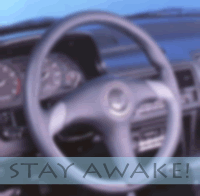|  Most
of us know that sleep is essential to our health, energy level, and attentiveness.
Yet millions of people simply don’t get enough sleep each night. The National
Sleep Foundation (NSF) reports that nearly two-thirds of American adults experience
a sleep problem a few nights a week or more. In fact, 43 percent of adults say
they are so sleepy during the day that it interferes with their daily activities
a few days a month or more. This lack of sleep can be especially hazardous on
the road. Most
of us know that sleep is essential to our health, energy level, and attentiveness.
Yet millions of people simply don’t get enough sleep each night. The National
Sleep Foundation (NSF) reports that nearly two-thirds of American adults experience
a sleep problem a few nights a week or more. In fact, 43 percent of adults say
they are so sleepy during the day that it interferes with their daily activities
a few days a month or more. This lack of sleep can be especially hazardous on
the road.
The
U.S. National Highway Traffic Safety Administration estimates that fatigued drivers
contribute to approximately 100,000 highway crashes, causing 71,000 injuries and
1,500 deaths each year.
Like
drugs and alcohol, sleepiness contributes to collisions because it slows reaction
time, decreases awareness, and impairs judgment. The NSF reports that sleepy drivers
are more tense and impatient and may even be driving faster when they should really
be stopping to rest. Research also shows that sleep-related crashes are most common
in younger drivers since young people tend to stay up later, sleep too little,
and drive at night. One
reason that driving drowsy is such a danger is that it’s difficult to stop
yourself from nodding off when you haven’t slept enough. While you may feel
that you can force yourself to stay awake, you can easily doze off without even
realizing it. And, when you’re driving, closing your eyes for even a second
can be disastrous. The
best strategy to cope with fatigue while on the road is simply to pull over in
a safe place and take a short nap. However, according to the NSF's 2000 poll,
only 22 percent of drivers report doing that. The majority, some 63 percent, look
to caffeine for relief from fatigue, but stimulants like caffeine are no substitute
for sleep. While drinking a cup of coffee or a can of soda may help you feel more
alert, the effects are temporary. In fact, even if you drink coffee, if you are
seriously sleep-deprived, you may experience "micro-sleeps"—brief
naps that last only four or five seconds. At 55 miles an hour, you can travel
more than 100 yards while you’re taking that five-second nap. Besides
monitoring your own level of alertness, you should also be cautious of other sleep-deprived
drivers on the road. In the NSF’s poll, half of all adults surveyed reported
driving while drowsy in the past year. And, among 18-to 29-year-olds surveyed,
24 percent reported that at some time they had dozed off while driving during
the past year. So, if you observe drivers drifting from lane to lane or jerking
their vehicles back into their lane, realize that they may be in danger of falling
asleep and stay clear of them. The
National Sleep Foundation offers these tips to help you stay awake while driving: 1.
Get a good night’s sleep each night. (Sleep experts recommend at least
eight hours of sleep a night in order to function properly, yet a full third of
American adults sleep six hours or less nightly during the work week.) 2.
Learn to recognize and pay attention to the warning signs of fatigue. Take
a break if you experience wandering or disconnected thoughts, yawn repeatedly,
have difficulty focusing or keeping your eyes open, or find yourself missing traffic
signs or tailgating other drivers. 3.
Don't count on tricks like turning up the radio or opening the window for
fresh air to keep you awake—these things will help for only a short while. 4. If you’re planning on driving a long distance, drive during the time of
the day when you are normally awake. 5.
Also, if possible, have someone accompany you and talk with that person
while driving. It's a good idea for your passenger to stay awake, too, so that
he or she can let you know if you are showing signs of sleepiness. 6.
On longer trips, schedule a break (in a safe area) every two hours or every
100 miles and stop sooner if you show any signs of sleepiness.
(source:
Amica
Mutual Insurance Company) |